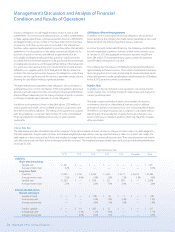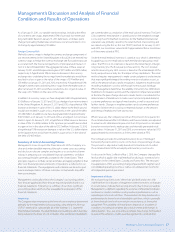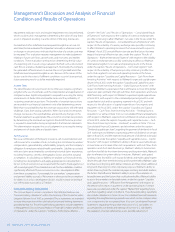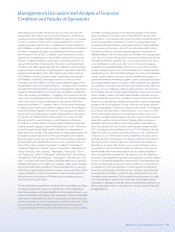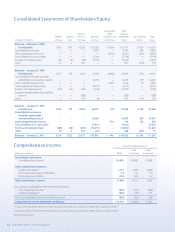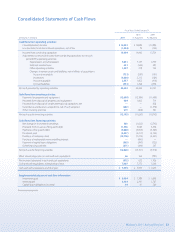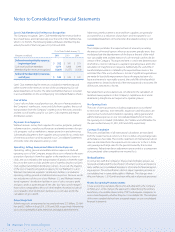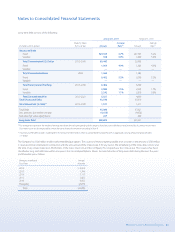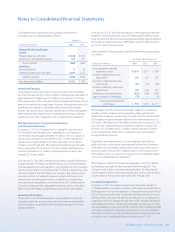Walmart 2011 Annual Report Download - page 38
Download and view the complete annual report
Please find page 38 of the 2011 Walmart annual report below. You can navigate through the pages in the report by either clicking on the pages listed below, or by using the keyword search tool below to find specific information within the annual report.
36 Walmart 2011 Annual Report
Sam’s Club Membership Fee Revenue Recognition
The Company recognizes Sam’s Club membership fee revenue both in
the United States and internationally over the term of the membership,
which is 12 months. The following table summarizes membership fee
activity for each of the scal years 2011, 2010 and 2009.
Fiscal Years Ended January 31,
(Amounts in millions)
2011 2010 2009
Deferred membership fee revenue,
beginning of year $ 532 $ 541 $ 551
Cash received from members 1,074 1,048 1,044
Membership fee revenue recognized (1,064) (1,057) (1,054)
Deferred membership fee revenue,
end of year $ 542 $ 532 $ 541
Sam’s Club membership fee revenue is included in membership and
other income in the revenues section of the accompanying Consoli-
dated Statements of Income. The deferred membership fee is included
in accrued liabilities on the accompanying Consolidated Balance Sheets.
Cost of Sales
Cost of sales includes actual product cost, the cost of transportation to
the Company’s warehouses, stores and clubs from suppliers, the cost of
transportation from the Company’s warehouses to the stores and clubs
and the cost of warehousing for our Sam’s Club segment and import
distribution centers.
Payments from Suppliers
Walmart receives money from suppliers for various programs, primarily
volume incentives, warehouse allowances and reimbursements for spe-
cic programs such as markdowns, margin protection and advertising.
Substantially all payments from suppliers are accounted for as a reduction
of inventory purchases and recognized in our Consolidated Statements
of Income when the related inventory is sold.
Operating, Selling, General and Administrative Expenses
Operating, selling, general and administrative expenses include all
operating costs of the Company, except those costs related to the trans-
portation of products from the supplier to the warehouses, stores or
clubs, the costs related to the transportation of products from the ware-
houses to the stores or clubs and the cost of warehousing for our Sam’s
Club segment and import distribution centers. As a result, the majority
of the cost of warehousing and occupancy for our Walmart U.S. and
Walmart International segments’ distribution facilities is included in
operating, selling, general and administrative expenses. Because we do
not include most of the cost of our Walmart U.S. and Walmart Interna-
tional segments’ distribution facilities in cost of sales, our gross prot
and gross prot as a percentage of net sales (our “gross prot margin”)
may not be comparable to those of other retailers that may include all
costs related to their distribution facilities in cost of sales and in the
calculation of gross prot.
Advertising Costs
Advertising costs are expensed as incurred and were $2.5 billion, $2.4 bil-
lion and $2.1 billion in scal 2011, 2010 and 2009, respectively. Advertising
costs consist primarily of print, television and digital advertisements.
Advertising reimbursements received from suppliers are generally
accounted for as a reduction of purchases and recognized in our
Consolidated Statements of Income when the related inventory is sold.
Leases
The Company estimates the expected term of a lease by assuming
the exercise of renewal options where an economic penalty exists that
would preclude the abandonment of the lease at the end of the initial
non-cancelable term and the exercise of such renewal is at the sole dis-
cretion of the Company. This expected term is used in the determination
of whether a store or club lease is a capital or operating lease and in the
calculation of straight-line rent expense. Additionally, the useful life of
leasehold improvements is limited by the expected lease term or the
economic life of the asset, whichever is shorter. If signicant expenditures
are made for leasehold improvements late in the expected term of a
lease and renewal is reasonably assured, the useful life of the leasehold
improvement is limited to the end of the renewal period or economic life
of the asset, whichever is shorter.
Rent abatements and escalations are considered in the calculation of
minimum lease payments in the Company’s capital lease tests and in
determining straight-line rent expense for operating leases.
Pre-Opening Costs
The costs of start-up activities, including organization costs, related
to new store openings, store remodels, expansions and relocations are
expensed as incurred and included in operating, selling, general and
administrative expenses on our Consolidated Statements of Income.
Pre-opening costs totaled $320 million, $227 million and $289 million for
the years ended January 31, 2011, 2010 and 2009, respectively.
Currency Translation
The assets and liabilities of all international subsidiaries are translated
from the respective local currency to the U.S. dollar using exchange rates
at the balance sheet date. The income statements of international subsid-
iaries are translated from the respective local currencies to the U.S. dollar
using average exchange rates for the period covered by the income
statements. Related translation adjustments are recorded as a component
of accumulated other comprehensive income (loss).
Reclassications
In connection with the Company’s nance transformation project, we
reviewed and adjusted the classication of certain revenue and expense
items within our Consolidated Statements of Income for nancial report-
ing purposes. The reclassications did not impact operating income or
consolidated net income attributable to Walmart. The changes were
eective February 1, 2010 and have been reected in all periods presented.
Recent Accounting Pronouncements
A new accounting standard, eective for and adopted by the Company
on February 1, 2010, changes the approach to determining the primary
beneciary of a variable interest entity (“VIE”) and requires companies to
assess more frequently whether they must consolidate VIEs. The adoption
of this new standard did not have a material impact on our consolidated
nancial statements.
Notes to Consolidated Financial Statements


